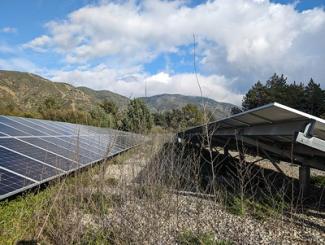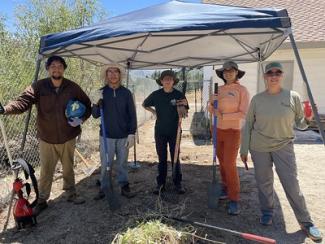Micro-grant used for weed abatement, native species planting at solar panel site
Gus Bahena, Region 05/San Bernardino National Forest
October 23rd, 2024

Solar panels contribute power to Front Country Ranger District visitor center, offices
If you build it, they will come.
Well, a solar panel site was built, and the weeds came. Lots of them and some were the invasive species type.

The solar panel site was getting overrun by invasive weeds. USDA Forest Service photo by Vanessa Mendez.
Photo Credit: Gus Bahena, Forest ServiceThe solar panels are located at the headquarters of the Front Country Ranger District for the San Bernardino National Forest in Lytle Creek, Calif. Forest Engineer Josh Direen explained that the solar production from the solar plant is designed to overproduce what is needed, which means the site is a net exporter. The exported energy is used to offset electric bills for most facilities on the west side of the forest through a Net Energy Metering Aggregation account with Southern California Edison.
Vanessa Mendez, the botany resource specialist for the district, saw an opportunity – an opportunity to apply for grant money from the USDA Forest Service Pacific Southwest Region to improve the solar panel site. She applied to and was awarded the grant this year that can be used to buy tools and supplies.

Marco Michel, a resotration coordinator with Southern California Mountains Foundation, cuts weeds behind the solar panel site, Aug. 17.
Photo Credit: Gus Bahena, Forest Service“The sustainable micro grant project from the region provides funding for sustainable projects, such as saving electricity, saving water,” Mendez said on a sunny, warm afternoon at Lytle Creek, Aug. 17. “For this project specifically, our solar panel area powers a lot of infrastructure on the district, but it gets overrun with weeds very badly every year. They grow very tall. We usually have to spray herbicide, which is costly. We don’t like to spray herbicide in the area of course. And then it’s an issue for any maintenance that we need; people can’t get in there, get to the panels and do any work that they need to do.”
Fortunately, the grant money allows for more than just cleanup of the site and providing access for the maintenance of the panels. The supplies that can be purchased include organics – plants and seeds.
The plan is to remove as many of the weeds as possible and convert the area to a pollinator garden, Mendez explained.
“So, we’ll be planting some water-wise, native plants under the panels and around the perimeter,” Mendez said. “We’ll also have some seed bulking beds for the restoration program. We’ll provide some native plant material that we can use for any restoration projects on the forest. And it’s just going to provide nice habitat for pollinators and wildlife.”
Mendez also said the restoration will help keep the weeds down and that they won’t have to use herbicide as much, if at all. She also explained that appropriate plants will be selected for the project.

Staff of the Southern California Mountains Foundation and the San Bernardino National Forest and a volunteer gather in the shade after a day of weed removal, Aug. 17.
Photo Credit: Gus Bahena, Forest Service“We have to be very particular about what plants we choose for under the panels,” Mendez said. “It has to be something that doesn’t grow out of control, is not going to damage the panels in any way and is not going to require a lot of water.”
However, the initial cleanup requires a lot of people power and that has included help from volunteers. The forest partner Southern California Mountains Foundation has been very supportive by providing volunteers and expertise. The foundation collaborates with Drew Farr, the forest restoration botanist, on the Green Thumbs program that oversees restoration projects, where volunteers help with weed removal, cleanups, planting of native species and work at three forest nurseries.
“SCMF is graciously helping us with the staff … and organizing through their Green Thumbs volunteer event to help with the labor for this project,” Mendez said.
One volunteer assisting at the solar panels site was Jaskiran Kaur of Chino Hills, Calif. She had just finished using a trowel shovel to remove coyote melon plants, which are a type of squash. This was her second time volunteering and expressed that ecological restoration is a very important cause for her.
“I love being out here, I love working on the land and I feel it’s a critical need right now,” Kaur said. “I also get a lot of peace and calm from working on the land.”

The work to improve the solar panel site was also a Green Thumbs Volunteer event hosted by the forest and Southern California Mountains Foundation. USDA Forest Service flyer by Drew Farr.
Photo Credit: Forest ServiceKaur thanked SCMF for the opportunity and said they were taking great care of the volunteers by making sure they took breaks and
stayed hydrated throughout the day.
“I’m really thankful,” Mendez said about the volunteers. “They’re really going out of their way to help with what’s essentially manual labor with weed removal…I’m very appreciative and thankful for that.”
The project is in its early stages. More cleanup has to be performed. And then the planning for the right type of species and the actual planting will be performed.
This is Mendez’s largest project to date, but she has enjoyed taking on the challenge.
“Very fun to work on, a little daunting, but I have a lot of support and help from Lisa Underwood of SCMF and Drew Farr – he’s helping me a lot with this too,” Mendez said.
Mendez is already looking at another solar panel site for a possible, similar project. That one was built near the Mill Creek facility of the forest that includes offices, a visitor center and a fire station.
With a helping hand from Green Thumbs and volunteers, those invasive species weeds don’t stand a chance when Mendez sets her sights on a restoration.


